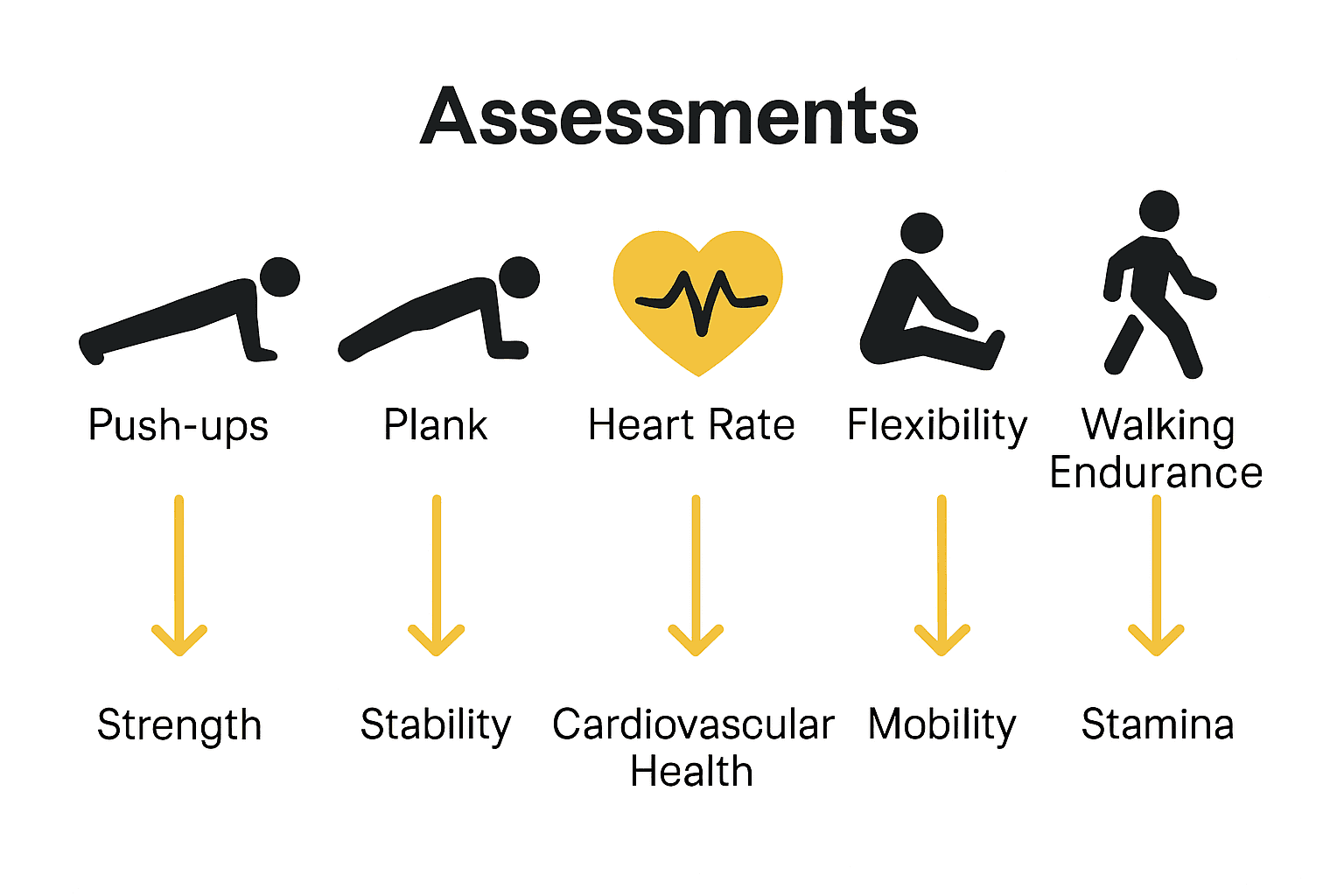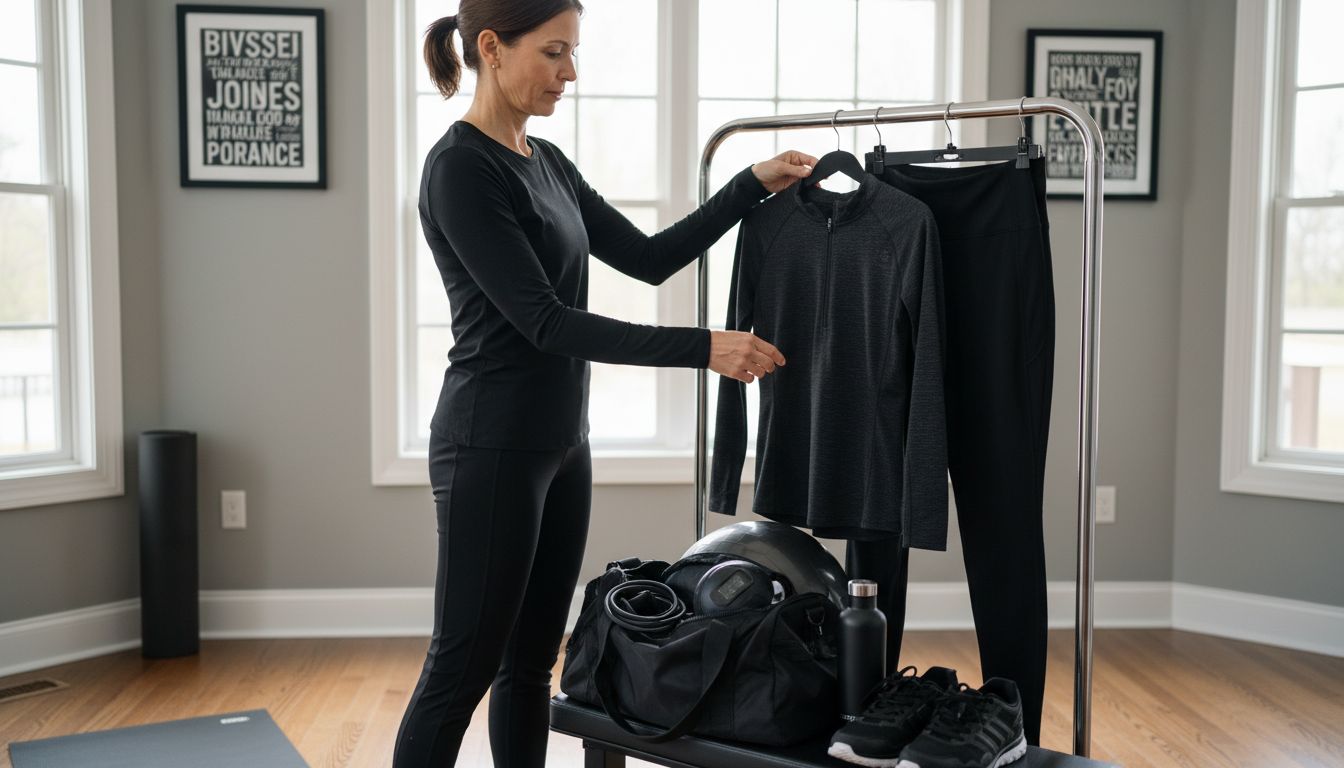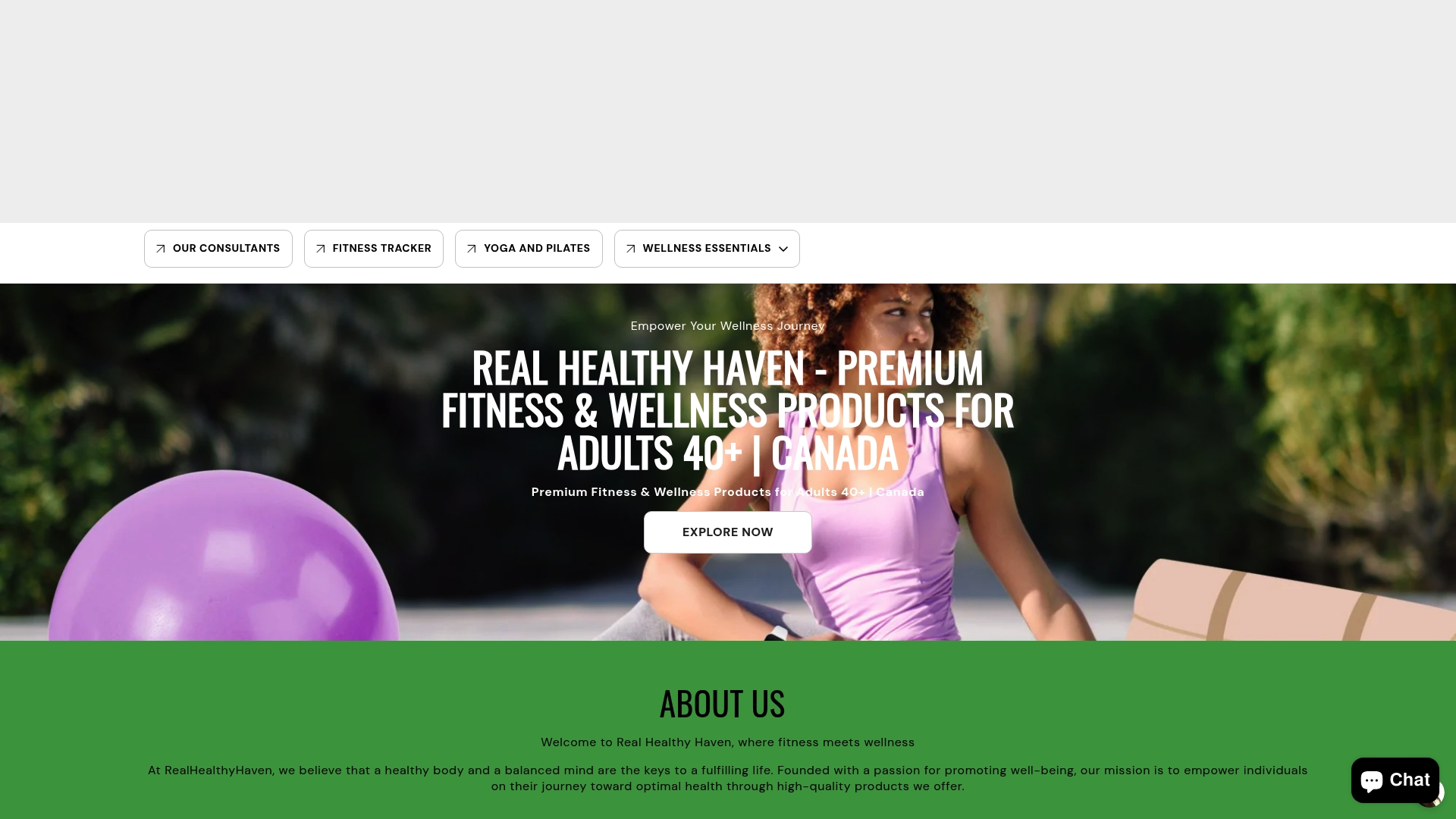Workout Routine for Adults 40+: Build Strength and Mobility

Did you know that only about one in five adults over 40 meet recommended fitness activity guidelines? Staying healthy after 40 becomes more challenging as metabolism slows and joint health changes. Finding the right approach can make all the difference for energy, strength, and quality of life. This guide delivers practical, age-specific steps so you feel confident building a routine that truly fits your needs.
Table of Contents
- Step 1: Assess Current Fitness Level And Set Goals
- Step 2: Choose Appropriate Equipment And Activewear
- Step 3: Design A Balanced Weekly Workout Plan
- Step 4: Perform Workouts With Safe Technique
- Step 5: Monitor Progress And Adjust Your Plan
Quick Summary
| Key Point | Explanation |
|---|---|
| 1. Assess your fitness accurately | Schedule a health assessment and conduct self-diagnostic tests to understand your current fitness level. |
| 2. Choose suitable activewear and equipment | Select comfortable, breathable clothing and appropriate equipment based on your fitness level to enhance your workout experience. |
| 3. Create a balanced weekly workout plan | Structure a varied exercise regimen that includes cardio, strength, flexibility, and rest days for optimal health and fitness. |
| 4. Prioritize safe exercise techniques | Focus on proper form and effective warm-up routines to minimize injury risk and maximize workout benefits. |
| 5. Regularly monitor and adapt your progress | Track your fitness journey through various metrics and adjust your routine to maintain motivation and continuous improvement. |
Step 1: Assess current fitness level and set goals
In this crucial first step, you’ll discover how to accurately evaluate your current physical condition and create meaningful fitness goals tailored for adults over 40. Understanding your starting point is key to designing an effective workout routine.
Begin by scheduling a comprehensive health assessment with your healthcare provider. According to Health Canada, using body mass index (BMI) and waist circumference can help you understand potential health risks and create baseline measurements.
Next, perform some self diagnostic tests that reveal your current fitness foundation. Conduct basic fitness evaluations like:
Here’s a comparison of common self-assessment tests and what they indicate for adults over 40:

| Assessment Type | What to Measure | Why It Matters |
|---|---|---|
| Pushup Test | Maximum in 1 minute | Upper body strength and endurance |
| Plank Hold | Longest time held | Core stability and strength |
| Resting Heart Rate | Beats per minute | Cardiovascular health |
| Flexibility Test | Distance reached (e.g., toe touch) | Mobility and injury prevention |
| Walking/Jogging Endurance | Time/distance completed | Aerobic fitness and stamina |
- Number of pushups you can complete in one minute
- How long you can hold a plank position
- Your resting heart rate
- Flexibility tests (like touching your toes)
- Walking or jogging endurance
The Public Health Agency of Canada recommends adults aim for at least 2.5 hours of moderate to vigorous aerobic activity weekly. Use these initial assessments to set realistic, progressive goals.
Pro Tip: Document your baseline measurements. These become your personal roadmap and motivation tracking tool.
After completing your assessment, you’ll have a clear picture of your current fitness level and can move forward with confidence in designing a personalized workout strategy that matches your unique health profile.
Step 2: Choose appropriate equipment and activewear
In this step, you will learn how to select the right workout gear that supports your fitness journey and keeps you comfortable and motivated. Choosing the right equipment and activewear is more than just looking good it is about creating an environment that encourages consistent exercise.
Public Health Canada emphasizes that comfortable and suitable activewear can significantly enhance your physical activity experience and boost your motivation to stay active.
When selecting activewear, prioritize these key factors:

- Moisture-wicking fabrics that keep you dry
- Flexible materials that allow full range of motion
- Comfortable fit that does not restrict movement
- Appropriate support for your specific workout type
- Breathable clothing that prevents overheating
For equipment, consider your fitness assessment results and choose items that match your current fitness level. Low impact options like resistance bands, stability balls, and light dumbbells are excellent for adults over 40.
Public Health Agency of Canada recommends selecting activities you genuinely enjoy and ensuring you have the right gear to participate safely and comfortably.
Pro Tip: Invest in quality pieces that make you feel confident. When you feel good in your workout clothes, you are more likely to stick to your fitness routine.
With the right equipment and activewear selected, you are now ready to move forward and design a workout plan that fits your lifestyle and fitness goals.
Step 3: Design a balanced weekly workout plan
In this critical step, you will craft a personalized workout strategy that keeps you active, engaged, and progressing toward your fitness goals. Creating a balanced weekly plan is about smart scheduling and variety that supports your overall health.
Public Health Canada recommends adults aim for at least 2.5 hours of moderate to vigorous aerobic activity spread throughout the week. This means breaking up your exercise into manageable sessions that fit your lifestyle.
Here is a sample weekly workout structure for adults over 40:
- Monday: Cardio (30 minutes walking or swimming)
- Tuesday: Strength training (light weights or resistance exercises)
- Wednesday: Flexibility and balance work
- Thursday: Rest or gentle stretching
- Friday: Cardio and light strength training
- Saturday: Longer endurance activity
- Sunday: Active recovery or rest
Public Health Agency of Canada specifically highlights the importance of incorporating balance and flexibility exercises to prevent falls and maintain overall mobility.
Pro Tip: Listen to your body. Some days you might need more rest. Flexibility in your plan is key to long-term consistency.
With this balanced approach, you have a solid framework for maintaining fitness and supporting your health as you progress through your 40s and beyond.
Step 4: Perform workouts with safe technique
In this crucial step, you will learn how to execute your exercises with precision and safety, minimizing injury risk and maximizing workout effectiveness. Understanding proper technique is fundamental to your fitness journey, especially as an adult over 40.
Public Health Canada emphasizes the importance of engaging in physical activities with proper technique to prevent injuries and optimize health benefits.
Start with a comprehensive warm up routine that includes:
- Gentle dynamic stretching
- Light cardiovascular movement
- Joint mobility exercises
- Gradual intensity increase
When performing strength exercises, focus on these key technique principles:
- Maintain proper spine alignment
- Move through full range of motion
- Control your breathing
- Start with lighter weights
- Prioritize form over weight or repetitions
Public Health Agency of Canada recommends older adults pay special attention to safe exercise practices, particularly warm up and cool down routines.
Pro Tip: Consider working with a certified fitness professional who can review your technique and provide personalized guidance.
By mastering safe workout techniques, you build a strong foundation for long term fitness and reduce the risk of potential injuries.
Step 5: Monitor progress and adjust your plan
In this final step, you will learn how to track your fitness journey systematically, ensuring continuous improvement and maintaining motivation. Monitoring your progress is not just about numbers it is about understanding your body and adapting your approach.
Public Health Canada emphasizes the importance of regularly tracking physical activity levels and health indicators to assess progress and make necessary workout adjustments.
Create a comprehensive tracking system that includes:
- Weekly body measurements
- Strength progression records
- Endurance and cardiovascular performance notes
- Energy levels and recovery time
- Subjective wellness journal entries
Use multiple assessment methods beyond weight and repetitions. Consider tracking:
- How your clothes fit
- Sleep quality improvements
- Stress reduction
- Overall mobility and flexibility
- Mental well being
Public Health Agency of Canada recommends older adults continuously monitor their physical activity and health status, making routine adjustments to maintain optimal well being.
Pro Tip: Review your progress monthly. Small consistent improvements matter more than dramatic short term changes.
By developing a thoughtful monitoring approach, you transform your fitness journey from a rigid plan to a dynamic personalized experience that evolves with your changing body and goals.
Elevate Your Workout Routine and Embrace Strength at 40 and Beyond
Struggling to build strength and maintain mobility as you age can be frustrating. The article highlights how adults over 40 need tailored fitness plans focused on safe techniques, balanced workouts, and proper equipment. You want to overcome challenges like joint discomfort, limited flexibility, and motivation dips while tracking real progress.
At Real Healthy Haven, we understand your goals and offer specialized solutions to support every step of your fitness journey. From comfortable, moisture-wicking activewear designed for your unique needs to reliable health monitors that help you track key indicators, our curated selection empowers you to build strength safely and confidently. Choosing the right gear can turn hurdles into milestones.

Take control today by exploring our range of gym clothes and find equipment that fits your routine perfectly. Visit Real Healthy Haven for quality products crafted to enhance your health and mobility. Start building a stronger, healthier you with tools made just for adults 40 plus.
Frequently Asked Questions
How can I assess my current fitness level as an adult over 40?
Begin by scheduling a health assessment with your healthcare provider. Perform self-diagnostic tests, such as pushup tests and flexibility assessments, to understand your starting point and tailor your fitness goals.
What should I include in my workout routine to build strength and mobility after 40?
Incorporate a mix of cardio, strength training, flexibility, and balance exercises into your weekly routine. Aim for at least 2.5 hours of moderate to vigorous activity spread throughout the week for optimal health benefits.
How can I choose appropriate equipment for my fitness level?
Select equipment based on your fitness assessment results, focusing on low-impact options like resistance bands, stability balls, or light dumbbells. This ensures safety and supports gradual improvement, especially if you’re just starting out.
What are some safe techniques to use during workouts for older adults?
Prioritize proper technique by maintaining spine alignment, moving through a full range of motion, and controlling your breathing. Start with lighter weights and emphasize form to minimize the risk of injury during exercises.
How should I monitor my progress in my workout routine?
Create a tracking system that includes your weekly body measurements, strength progression, and subjective wellness journal entries. Review your progress monthly to adjust your workout plan and ensure continuous improvement.
How can I ensure that I stay motivated with my workout routine?
Set realistic and progressive goals based on your fitness assessments to keep your routine challenging. Document your achievements and celebrate small improvements to help maintain your motivation and commitment to your fitness journey.

